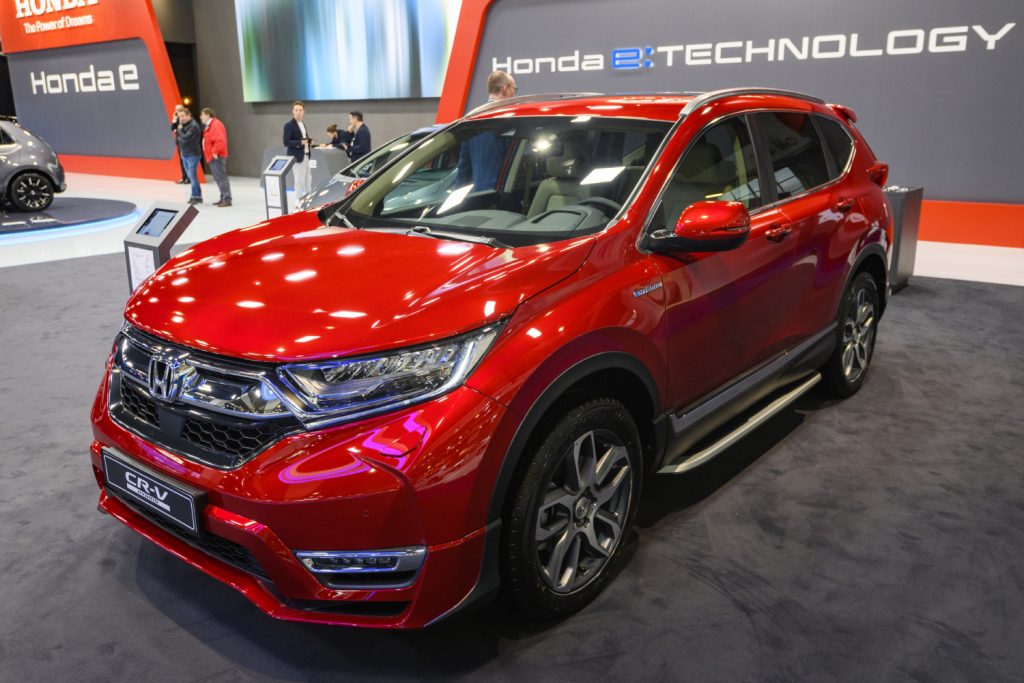According to U.S. News, the 2021 Honda CR-V is the runner-up on their list of the best compact SUVs for families. It has earned the silver medal, but not the gold. The 2021 Toyota RAV4 serves as the best compact SUV for families instead.
Other victories that the Honda CR-V didn’t claim include the best compact hybrid and best compact SUV to buy. It generally remains in the top three options but never earns the number one spot.
The Honda CR-V vs. Toyota RAV4 battle continues…
The Honda CR-V has been battling the Toyota RAV-4 for a while now. But since the RAV4 received a refresh in 2019, it’s been hard to beat. To make matters worse for the Honda CR-V, the Toyota RAV4 is the best-selling compact SUV option.
It makes us wonder things like, are Honda CR-Vs reliable? What holds it back from being the number one option for families? According to Consumer Reports, the Honda CR-V is very reliable. It has a predicted reliability rating of four out of five, which is above average.
Also, Consumer Reports gave the Toyota RAV4 a predicted reliability rating of three out of five, which is average. This data is based on issues reported by owners on previous models, and the 2019 and 2020 RAV4 models have more issues reported than the 2019 and 2020 CR-V models.
But when the CR-V vs. RAV4 battle comes down to family features, the RAV4 is more advanced. While the CR-V and RAV4 were both refreshed for 2019, the Toyota RAV4 got better tech upgrades.
U.S. News noted that the standard five-inch infotainment center that comes standard in the Honda CR-V is a disappointment. It looks outdated and lacks functionality. They recommend springing for the larger 7.5-inch touchscreen with Apple CarPlay and Android Auto. It’s offered on high trim levels.
Meanwhile, the Toyota RAV4 comes with a standard seven-inch touchscreen that supports Apple CarPlay and Android Auto. You can also upgrade to an eight-inch screen. The system is fast and easy to use.
What makes the Honda CR-V good for families?
Aside from lacking tech, the 2021 Honda CR-V has tons of great family-friendly features. For example, it has up to 75.8 cubic feet of cargo space. Its large opening and low liftover height make it easy to load bulky items, and a hands-free power liftgate is available. The 2021 Toyota RAV4 offers up to 68,8 cubic feet of cargo space and has a hands-free liftgate.
The interior of the Honda CR-V is spacious, with plenty of room for taller passengers and car seats. It’s full of soft-touch surfaces but does include some hard plastics.
The Toyota RAV4 has a durable interior with quality materials that also include plastics. The seats are supportive, but the rear seat space isn’t as ample.
Both of these SUVs have a similar fuel economy too. But the Toyota RAV4 offers road sign recognition, and the Honda CR-V does not. If you can get past the slightly outdated tech, you may like the Honda CR-V more.
Is The Honda CR-V Hybrid Worth Buying?
Like a majority of other modern SUVs, the Honda CR-V is going hybrid to offer a more fuel-efficient model. However, is the Honda CR-V Hybrid actually worth buying? Let’s see how it compares to the non-hybrid model to see if the extra fuel savings are worth it.
Should I Buy The Honda CR-V Hybrid?
Let’s take a look at the prices. The Honda CR-V Hybrid starts around $27k, which isn’t bad at all. This isn’t much more than the non-hybrid version, which starts around $25k. So, for about $3k extra, you can enhance your fuel economy.
2020 Honda CR-V Hybrid | Honda
The Honda CR-V already has an above-average fuel economy, though. It gets an average of 28 mpg in the city and 32 mpg in the city. These numbers excel against competitors.
However, with the Honda CR-V Hybrid, you get 40 mpg in the city and up to 35 mpg on the highway. This shows us that if you live in the city, then the extra fuel savings could be worth it.
But before you decide if the Hybrid Honda is worth it or not, consider how it performs.
How The Honda CR-V Hybrid Performs
The Honda CR-V Hybrid is equipped with a 2.0-liter four-cylinder engine and two electric motors. One electric motor is for propulsion, and the other is a starter-generator.
This build pumps out 212 horsepower and makes the Hybrid model all-wheel drive, giving it the capability to traverse through snow and other slippery conditions.
But the Honda CR-V Hybrid isn’t ranked for towing. So if you have anything to pull, avoid this option.
On a positive note, the Honda CR-V has a peppy acceleration, making it fun to drive around. It can go from 0 to 60 mph in only 7.7 seconds.
The Honda CR-V has a bit more power, which gives it the ability to tow up to 1,500 lb. So, it can only tow very light items.
Also, the non-hybrid version has a similar amount of pep and can go from 0 to 60 mph in only 7.6 seconds.
Honda CR-V Hybrid Features
With the CR-V Hybrid and non-hybrid models, you don’t get much in terms of tech unless you spring for a higher trim option.
For example, you have to spend about $3k extra with both models to have Apple CarPlay and Android Auto connectivity with the infotainment center.
If you would like a wireless phone charger near the center console, go ahead and shell out enough cash for the highest trim options.
As far as we can tell, the Hybrid CR-V doesn’t incorporate any extra safety or tech features. No extra luxury is included either.
The Honda CR-V Hybrid seems to only come with a better fuel economy and a pretty good eight-year warranty on the battery. However, most hybrid models offer a 10-year warranty on the battery.
The Honda CR-V Hybrid is worth buying if you would like the extra fuel economy. If you would like to tow anything that weighs 1,500 lb or less, then don’t go with the Hybrid option. Otherwise, the Honda CR-V Hybrid is pretty much identical to the regular Honda CR-V.













